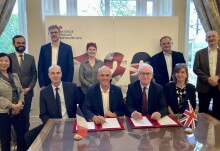

The World Weather Attribution group, led by the Grantham Institute’s Dr Fredi Otto, releases their latest climate attribution findings.
Human-caused climate change made the record-breaking heatwave in northern Argentina and Paraguay in early December 60 times more likely.
This is are according to a rapid attribution analysis by an international team of leading climate scientists as part of the World Weather Attribution (WWA) group, led by the Grantham Institute’s Dr Fredi Otto.
During the heatwave, nine locations in northern Argentina registered their highest maximum temperature for December since at least 1961, with the country experiencing heat-related deaths, large-scale power outages, wildfires, and poor harvests.
Large regions in Northern Argentina and neighbouring countries began experiencing unusually high temperatures in mid-November, followed by a second heatwave in early December, with temperatures exceeding 40°C in 24 locations, and above 45°C in four.
This made the region near the Argentinian border with Bolivia and Paraguay (Rivadavia station), one of the hottest places on earth on the 7 December, with a temperature of 46°C.

Climate change has its fingerprints all over it
Across the world, climate change has made heatwaves more common, longer and hotter. Without the effects of greenhouse gas emissions, this heatwave would have been an extremely unusual event, said the WWA, but could now be expected to happen once every 20 years as a result of human-induced climate change, with a 5% chance of it happening each year.
Such events are also likely to become more extreme (hotter), with heatwaves like this one being about 1.4°C hotter because of climate change.
"The fingerprints of global warming are now evident in every episode of extreme temperature across the world...deadly events that a few decades ago were extremely unlikely are now becoming possible" Dr Fredi Otto
Dr Otto, Senior Lecturer in Climate Science at the Grantham Institute for Climate Change and the Environment, Imperial College London, said:
“We don't need attribution studies to know that this or any other heatwave was made worse by climate change. The fingerprints of global warming are now evident in every episode of extreme temperature across the world.
"What our analysis shows, is that deadly events that a few decades ago were extremely unlikely are now becoming possible. And that unless we cut greenhouse gas emissions, they will become more and more frequent.”

Increased deaths
Increases in heat-related deaths were unequally distributed across demographics, with poorer neighbourhoods often experiencing higher temperatures, due to a lack green space, inadequate insulation against heat, and lack of electricity, shade, and water.
“Heatwaves are one of the clearest and the most overlooked impacts of climate change" Roop Singh
Roop Singh, Climate Risk Adviser at the Red Cross Red Crescent Climate Centre, said:
“Heatwaves are one of the clearest and the most overlooked impacts of climate change. Not only are they silent killers, causing high numbers of deaths that often go uncounted, but they can also have huge economic impacts, as they reduce productivity and destroy crops.
"The latter is particularly important in countries such as Argentina, which rely heavily on agricultural exports.”
global food prices expected to rise
Argentina is South America’s largest exporter of wheat, but the region is currently experiencing a prolonged drought that started in 2019, and since drought and heat reinforce each other, the impacts on food production are a big concern.
Harvests are expected to be the worst in seven years, with large economic losses for farmers and the country’s Treasury as a result of reduced exports. As a major player in the world’s wheat market, this could mean further increases in global food prices.

Juan Rivera, scientist at the Argentine Institute for Snow Research, Glaciology and Environmental Sciences (IANIGLA), said:
“There is growing concern in Argentina and South America over heatwaves, which have become more frequent and severe in the last few decades. These recent events are a clear example of this.
“Unless carbon emissions are reduced, climate change will continue to favour the occurrence of record-breaking temperatures in late spring and early summer, at a time of the year when people are not prepared to deal with extreme heat".

How WWA analysed the data
WWA scientists analysed weather data and computer model simulations to compare the climate as it is today, after about 1.2°C of global warming since the late 1800s, with the climate of the past, following peer-reviewed methods.
This is the first study that WWA has conducted of an extreme weather event in either Argentina and Paraguay. The analysis focused on the daily maximum temperature for the hottest one-week period, from 4-10 December 2022.

What is WWA?
The World Weather Attribution group is an international collaboration between leading climate scientists, that meet when an extreme weather event occurs, such as storms, extreme rainfall, heatwaves, cold spells, and droughts. The scientists run a rapid attribution analysis of the possible influence of climate change.
This particular study was conducted by 18 researchers, including scientists from universities and meteorological agencies in Argentina, Colombia, Denmark, France, the Netherlands, New Zealand, South Africa, Switzerland, the UK, and the US. WWA will conduct a further study of the drought over the coming months.
Earlier this year, WWA scientists found that drought in the Northern Hemisphere was made more likely by climate change, as was the increased rainfall that led to a third of Pakistan being flooded.
Follow WWA on Twitter for the latest analysis.
Article text (excluding photos or graphics) © Imperial College London.
Photos and graphics subject to third party copyright used with permission or © Imperial College London.
Reporter
Jez Fredenburgh
The Grantham Institute for Climate Change

Contact details
Email: press.office@imperial.ac.uk
Show all stories by this author




Leave a comment
Your comment may be published, displaying your name as you provide it, unless you request otherwise. Your contact details will never be published.